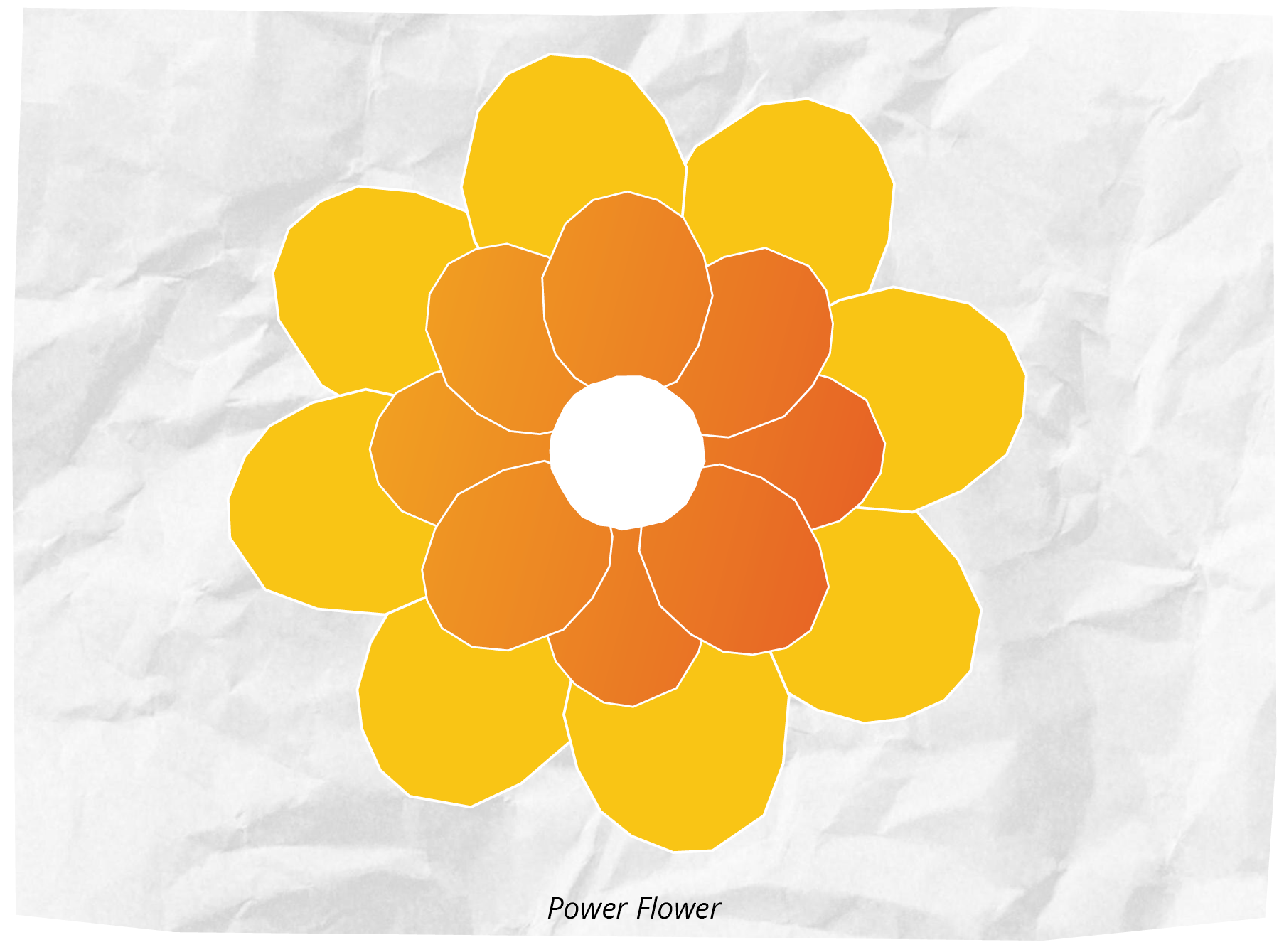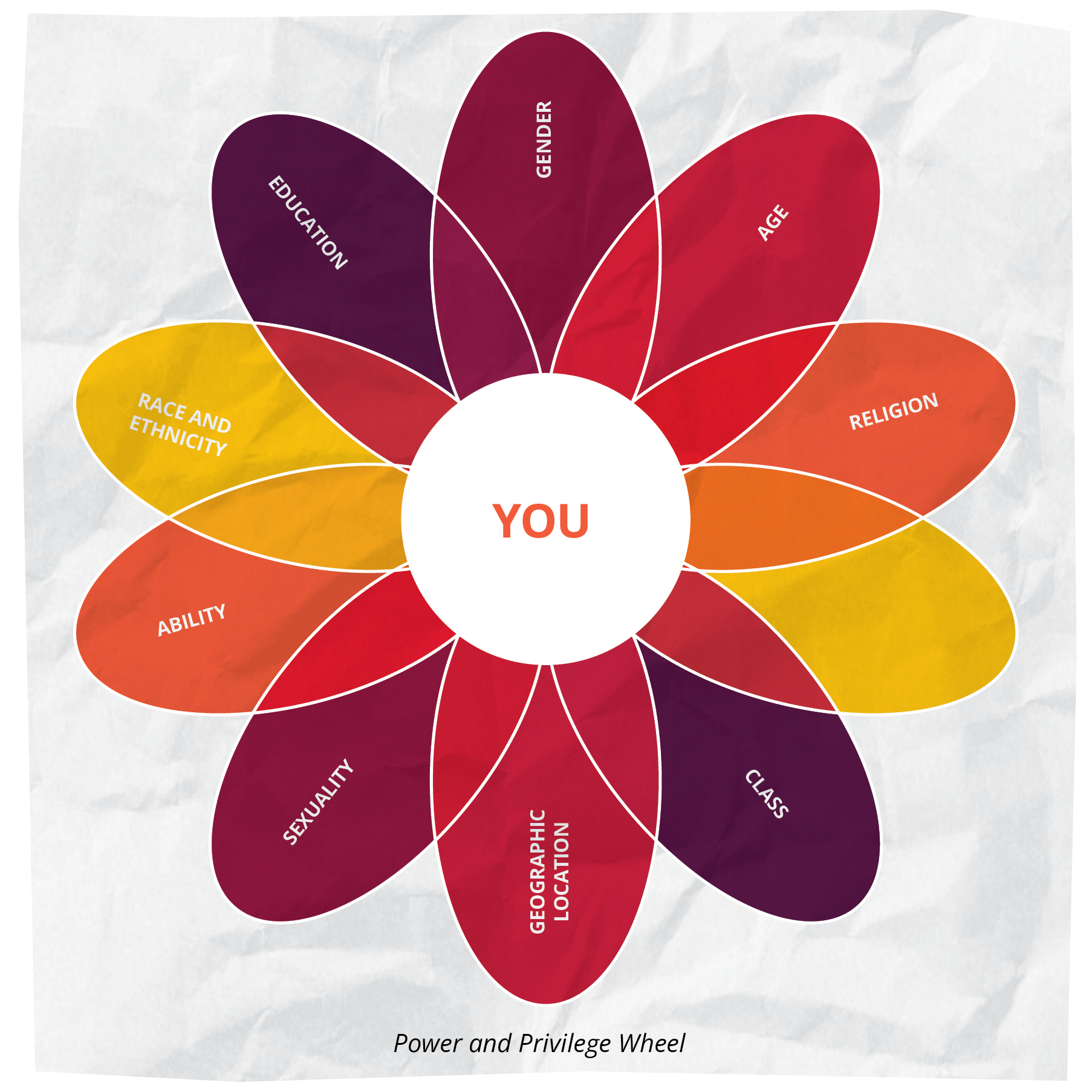Theme 1: Identity, Power, and Privilege
How we think about and experience our identities – and their intersections – is both a personal question and one that is shaped by societal norms and structures. Depending on our context, the identities we inhabit translate into differing levels of power, access, and privilege in relationship to other people.
Understanding these inequities and the ways they affect not only our own lives, but also our organisations and work for social change, can unleash more transformative strategies.
The various aspects of our identity intersect, and so we experience power differently, resulting at times in relative privilege and, at other points, in oppression, subordination, and exclusion. Understanding identity and power can move us toward more freeing and equitable ways of being and working.
Activity 1: Identity and the Power Flower
Every one of us has multiple, nuanced identities. Gender, race, ethnicity, sexuality, class, and age, among others, intersect and interact to shape who we are, how we are treated, and what challenges and contradictions we confront.
Set the tone for a safe open discussion. People may experience shame, anger, grief, or guilt when they talk about aspects of their identity. Make it clear that the purpose here is to deepen our understanding together so that we can work more effectively toward justice and mutual liberation.
Materials: Poster-size version of the Power Flower; Handout: Identity and the Power Flower; personal notebooks or sheets of paper for each person; markers.
Step 1. Who am I?
Plenary: Introduce the theme and activity. This is the first step in exploring who we are through our various identities, illuminating the ways they shape our lives.
Individually: Each person writes or draws their responses to the questions.
- What were you taught about difference and people different from you?
- What were you taught about your ‘place’ in social hierarchies?
- How has that affected your life?
- How might what you learned shape your work for social change?
People can choose to share or not. Either way, their thoughts will inform the activity.
Step 2. How identity has shaped our lives
Plenary: Post a poster-sized copy of the multi-petaled Power Flower on the wall. Invite people to name different categories of identity. These can include: gender, race, ethnicity, sexuality, class, religion, ability/disability, age, education, marital status, and/or location (urban/ suburban/rural). Write labels on most of the petals but leave a few blank so that people can add other categories.
Most of these categories are not binary but instead encompass multiple options (such as male, female, trans, intersex, non-binary) and dimensions (such as gender non-conforming) that add layers of complexity to gender. Everyone navigates multiple forms of identity – some remaining the same, others changing over the course of their life. Emphasise that no identity has more intrinsic worth or value than any other.

Individually: Each person identifies six or seven of their own personal characteristics/identities in relation to the categories decided by the group and fills in the petals on their handout (or draws their own and Power Flower).
Next, each person writes three words or draws three sketches on a sheet of paper to show:
- A part of your identity that makes you feel strong, safe, or proud.
- A part of your identity that has made you feel less valued, vulnerable, or powerless at times in your life.
- A part of your identity that has in some way shaped your life’s purpose.
These may be three different parts of your identity or the same.
Plenary: Form a circle. Invite each person in turn to hold up their sheet of paper and explain the three parts of their identity, without questions or discussion.
In pairs: Each person finds someone with one matching element. Pairs have ten minutes to share. People may form mixed pairs instead and discuss what they might have in common.
Plenary: Share any reflections or ‘aha!’ moments. Talking about identity is not an everyday conversation. Ask:
- What was it like to talk about your identities with others? Did you feel any discomfort? What if anything helped you have this conversation?
- What did you learn about identity and difference and how society values or devalues certain identities? How does the experience of identity change in different circumstances?
- Did you gain any insights about your identities and how they shape your experience in specific ways?
Identity is complex. It is not fixed. We are assigned some aspects at birth or by family, other aspects are fixed, changed, or are imposed on us, and some we choose or claim. Depending on the context, identity shapes our experience, access, opportunities, and safety.
Download this activity.
Download handout: The Power Flower.
Identity is relational. In one context you may have more privilege than other people, but in another you may have less. Identity does not automatically convey value, privilege, and power – value is assigned to different identities through systems of power.
We tend to think of identity as individual. But the social meaning of any specific identity and the power and privileges it bestows – or denies – are systemic and structural.
Identity-related benefits accrue whether or not the group or individuals actively seek them. Privilege seems obvious in many ways, but those who have it can be blind to it. Those excluded from forms of privilege and power tend to be highly aware of these inequities and may share outrage with others with similar experience, but they may not feel they can risk speaking about it in mixed groups.
In both cases – privilege and exclusion – we end up divided and disconnected when we do not talk about our experience for fear of feeling shame, pain, anger or guilt, or being exposed to judgement or backlash. As a result, we leave privilege, and its flipside – inequity, oppression, marginalisation, exclusion – intact and unchallenged.
We must cultivate awareness and open conversations in safe spaces to build trust and solidarity for collaboration and equitable relationships.

Download handout: Power and Privilege Wheel.
Activity 2: The continuum of identity, power, and privilege
Materials: One large copy of the Power and Privilege Wheel to display on the wall. One small copy per person.
Step 1: Identity and privilege
Build on the Power Flower by adding another layer. Show how identities intersect with forms of systemic power and are thus afforded differing levels of privilege. This in turn translates into access, voice, choices, resources and power.
Plenary: Read out these two sentences to open a discussion.
- “Our society assigns value and gives greater privilege and power to certain identities than it does to others.”
- “Privilege is, simply put, a set of unearned benefits given to people who fit into a specific social group.”6
Brainstorm examples of forms of privilege in your context, defined as “benefits given to people because they are from specific social groups”.
- How are specific identities offered or excluded from power and privilege?
- How do these differences in privilege show up in your context?
- What impact do the differences have on people, communities and organisations?
You may need to clarify the ways in which the benefits of privilege differ from efforts to address past and present inequity such as gender-specific safe spaces or proactive opportunities such as quotas for historically marginalised groups. If these topics are new or unfamiliar, you may want to collectively define the ways that these terms connect identity with power inequities:
- White/light skin privilege
- Male privilege
- Heterosexual privilege
- Class privilege
Step 2: The Power and Privilege Wheel
Plenary: Introduce the activity and hand out the Power and Privilege Wheel. Check that everyone understands what the wheel shows. Identities closer to the centre of the wheel are afforded more privilege and value by society than those further out. These may vary according to context but hold true overall.
Post a large graphic of the flower or wheel on the wall and invite everyone to come up and write on it. With bigger groups, brainstorm collectively with a few people writing suggestions on the wheel.
On each petal – for example, gender or ‘race’ – write the socially dominant identity close to the centre, for example male or white. Write the less dominant identities on the outside edge of the petal. There may be various non dominant identities on any petal, such as female, trans, non-conforming on the gender petal.
Individually: On their handout, each person notes for each petal where they identify and how that sits in relationship to the relative degrees of power.
Small groups: In groups of three, discuss these questions, sharing only what feels comfortable.
- Have you ever been aware that aspects of your identity afforded you more or less access, safety, and/ or power in a situation? Have you been excluded, targeted, or discriminated against because of some part of your identity?
- Have any aspects of your identity changed over time? How does your sense of power or privilege change depending on where you are, who you are with, or what you are doing?
- Have you ever felt like you had to hide or leave some part of your identity out? Do you ever change the way you reveal or express your identities depending on the context, and if so, why? (Examples could be your accent, vocabulary, dress code, or openness about your sexuality.)
Plenary: Share any ‘aha!’ moments.
- What was the most important realisation for you?
- What did this add to your understanding of identity and its meaning in your context?
- How did this activity connect your experience of identity with broader systems and structures that shape power and privilege – determining who is valued, who has a voice, who benefits?
- Was there anything that surprised you? Anything that felt uncomfortable? Anything that felt validating?
Going deeper: You may decide that your group would benefit from exploring this further. For instance, a lack of clarity and forthright discussion – about race, ethnicity, class, gender or another aspect – may be blocking the group’s ability to work in politically aligned and coherent ways. If so, you could use or adapt one of the many tools designed to surface deeper awareness about specific types of privilege. Address particular ‘blind spots ’ or areas of tension around the privileges afforded to some identities over others, in order to build a shared commitment to dismantling systems of inequity.
Download this activity.
______________________________
6 From Everyday Feminism website article
